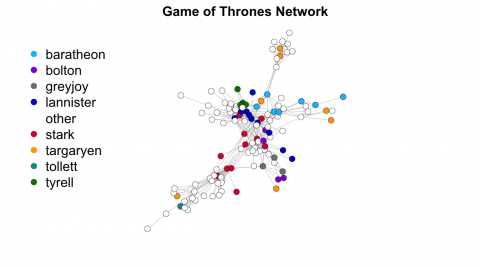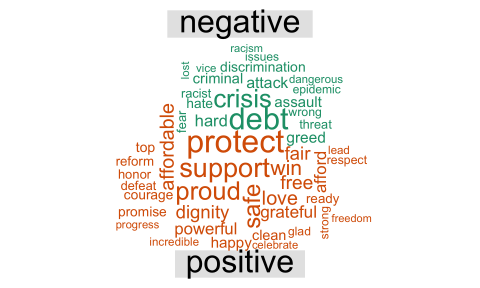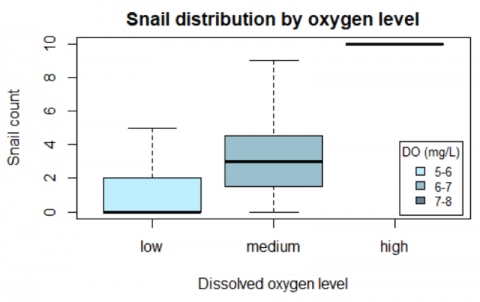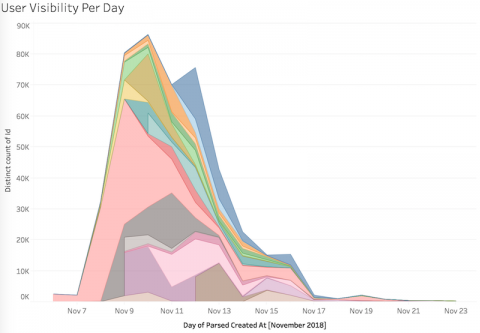2019 Projects
We led a 75-minute class session for the Marine Mammals course at the Duke University Marine Lab that introduced students to strengths and challenges of using aerial imagery to survey wildlife populations, and the growing use of machine learning to address these “big data” tasks. Graduate students: Gregory Larsen and Patrick...
The goal of this Data Expedition was to introduce students to the exploration of social networks data using R. Students learned to load and plot a social network in R and then perform some basic analyses on two different networks: Hockey Fights in the National Hockey League in 2018-2019 and...
The data that students see in their statistics courses are often constrained to numeric and tabular data. However, there is an exciting field of data science and statistics known as text analysis. This expedition introduces students to the concept of treating text as data frames of words, and demonstrates how...
Fluid mechanics is the study of how fluids (e.g., air, water) move and the forces on them. Scientists and engineers have developed mathematical equations to model the motions of fluid and inertial particles. However, these equations are often computationally expensive, meaning they take a long time for the computer to...
This project allowed students in BIOL 268D (Mechanisms of Animal Behavior) to explore the relationship between estrogen, female sexual swellings, and male mating success in wild baboons using data from the Amboseli Baboon Research Project. Students learned how to use the popular R packages dplyr and ggplot2 to calculate descriptive statistics about the dataset...
Ecological data comes in various shapes and sizes. When conducting an ecological study, it is common to have population data (such as snail counts) and continuous sensor data (such as stream temperature with 35,000 data points collected each year!). Ecologists must reconcile data collected at different spatial and temporal scales...
Cassandra Turk (Economics) and Alec Ashforth (Economics, Math) spent ten weeks building tools to help minimize the risk of trading electricity on the wholesale energy market. The team combined data from many sources and employed a variety of outlier-detection methods and other statistical tools in order to create a large dataset of extreme...
Andre Wang (Math, Statistics), Michael Xue (Computer Science, ECE), and Ryan Culhane (Computer Science) spent ten weeks exploring the role played by emotion in speech-focused machine-learning. The team used a variety of techniques to build emotion recognition pipelines, and incorporated emotion into generated speech during text-to-speech synthesis. Click here to read the Executive Summary Faculty...
KC and Patrick led two hands-on data workshops for ENVIRON 335: Drones in Marine Biology, Ecology, and Conservation. These labs were intended to introduce students to examples of how drones are currently being used as a remote sensing tool to monitor marine megafauna and their environments, and how machine learning...
This two-week teaching module in an introductory-level undergraduate course invites students to explore the power of Twitter in shaping public discourse. The project supplements the close-reading methods that are central to the humanities with large-scale social media analysis. This exercise challenges students to consider how applying visualization techniques to a...
Social and environmental contexts are increasingly recognized as factors that impact health outcomes of patients. This team will have the opportunity to collaborate directly with clinicians and medical data in a real-world setting. They will examine the association between social determinants with risk prediction for hospital admissions, and to assess...
Aaron Chai (Computer Sciece, Math) and Victoria Worsham (Economics, Math) spent ten weeks building tools to understand characteristics of successful oil and gas licenses in the North Sea. The team used data-scraping, merging, and OCR method to create a dataset containing license information and work obligations, and they also produced ArcGIS visualizations of...
Yueru Li (Math) and Jiacheng Fan (Economics, Finance) spent ten weeks investigating abnormal behavior by companies bidding for oil and gas rights in the Gulf of Mexico. Working with data provided by the Bureau of Ocean Energy Management and ExxonMobil, the team used outlier detection methods to automate the flagging of abnormal behavior,...
Varun Nair (Economics, Physics), Paul Rhee (Computer Science), Jichen Yang (Computer Science, ECE), and Fanjie Kong (Computer Vision) spent ten weeks helping to adapt deep learning techniques to inform energy access decisions. Click here to read the Executive Summary Faculty Lead: Kyle Bradbury Project Manager: Fanjie Kong
Yoav Kargon (Mechanical Engineering) and Tommy Lin (Chemistry, Computer Science) spent ten weeks working with data from the Water Quality Portal (WQP), a large national dataset of water quality measurements aggregated by the USGS and EPA. The team went all the way from raw data to the production of Pondr, an interactive and...
Marco Gonazales Blancas (Civil Engineering) and Mengjie Xiu (Masters, BioStatistics) spent ten weeks building tools to help Duke reduce its energy footprint and achieve carbon neutrality by 2024. The team processed and analyzed troves of utility consumption data and then created practical monthly energy use reports for each school at Duke. These reports...
Cathy Lee (Statistics) and Jennifer Zheng (Math, Emory University) spent ten weeks building tools to help Duke University Libraries better understand its journal purchasing practice. Using a combination of web-scraping and data-merging algorithms, the team created a dashboard to help library strategists visualize and optimize journal selection. Click here to read the Executive Summary Faculty...
Team A: Video data extraction Alexander Bendeck (Computer Science, Statistics) and Niyaz Nurbhasha (Economics) spent ten weeks building tools to extract player and ball movement in basketball games. Using freely available broadcast-angle video footage which required much cleaning and pre-processing, the team used OpenPose software and employed neural network methodologies. Their pipeline fed...
Showing 1-20 of 35 results



















